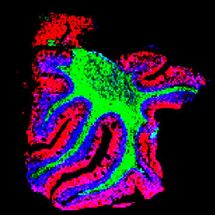One Drug, Three Action Modes
Chemotherapy and photodynamic therapy combined in a single drug to fight resistant cancers
Clinicians combat the drug resistances of some cancer types by using a combination of different drugs. To make this approach more effective, chemists have designed a chemical conjugate that can simultaneously attack several cellular targets using different modes of action. Such a single-drug therapy would increase the chances of killing all cancer cells, the authors state in the journal Angewandte Chemie.

© Wiley-VCH
The most frequently clinically applied chemotherapeutic drug is cisplatin, a metal complex based on the platinum(II) ion. The drug’s mode of action is binding to the DNA in the tumor cells, where it distorts the DNA structure and ultimately triggers cell death. Other chemicals facilitate the interaction of cisplatin with DNA, and they are often combined with cisplatin for chemotherapy. The photodynamic therapy (PDT) approach, in contrast, relies on the activation of a metal complex by laser light. A reactive form of oxygen is formed, which interferes with cell metabolism, triggering cell death.
“In clinical protocols, each drug is administered separately and may not reach the tumor at the same time or at a fixed ratio,” says Prof. Gilles Gasser from the Paris Sciences et Lettres (PSL) University in Paris, France, who is one of the leading authors of the study. His group, in collaboration with Prof. Dan Gibson’s group from Hebrew University, Jerusalem, Israel, combined cisplatin, phenylbutyrate, which is a chemical enhancer for cisplatin, and a PDT drug, which is a metal complex based on ruthenium(II), into a single compound called Ru-Pt. The idea was that the three drugs in conjunction could travel the bloodstream intact and enter their target tumor cells, which would reduce side effects and the need to adjust the dosages.
The scientists have designed the phototherapeutic Ru(II) half of Ru-Pt so that it can be excited with laser light in the deep red section of the wavelength spectrum, which penetrates deeply in the biological tissue. The cisplatin and phenylbutyrate containing half of Ru-Pt was designed as a prodrug, which would be activated by cellular components inside the cell. Both therapeutic components were attached to each other by a molecular spacer. “The correct spacer length was critical to ensure that both drug compounds will not interfere with each other, but the molecule remains small, water-soluble, and able to travel across membranes,” Gasser says.
The researchers added Ru-Pt to some normal and cancer cell lines and found that Ru-Pt was significantly more efficient in killing cancer cells than the single compounds Ru(II) and Pt(IV). The authors also reported that the irradiated samples had significantly higher tumor-killing rates, which means that the specific drug activation in tumor tissue is possible. And finally, Ru-Pt had a ten times higher efficiency for drug-resistant cell lines than the single reagents. These results demonstrate the high potential of multimodal drugs for developing more selective and effective drugs that have fewer side effects and allow for a simple handling for an effective cancer treatment.
Original publication
Original publication
Gilles Gasser et al.; "A Multi‐action and Multi‐target RuII–PtIV Conjugate Combining Cancer‐Activated Chemotherapy and Photodynamic Therapy to Overcome Drug Resistant Cancers "; Angewandte Chemie International Edition; 2020
Organizations
Other news from the department science

Get the life science industry in your inbox
By submitting this form you agree that LUMITOS AG will send you the newsletter(s) selected above by email. Your data will not be passed on to third parties. Your data will be stored and processed in accordance with our data protection regulations. LUMITOS may contact you by email for the purpose of advertising or market and opinion surveys. You can revoke your consent at any time without giving reasons to LUMITOS AG, Ernst-Augustin-Str. 2, 12489 Berlin, Germany or by e-mail at revoke@lumitos.com with effect for the future. In addition, each email contains a link to unsubscribe from the corresponding newsletter.
Most read news
More news from our other portals
Last viewed contents
Hypermellose
Scientists Image Plant "Attack" Signaling System - Techniques pioneered for medical science shed light on plants' internal communications
Zingiberene




















































